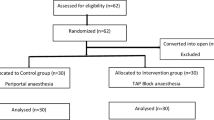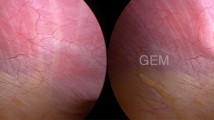Abstract
Background
Ultrasound-guided transversus abdominis plane block (US-TAP) is an important component of multimodal analgesia in laparoscopic inguinal hernia repair, although it has certain limitations. To overcome them, surgeons have developed several techniques to perform local anesthetic infiltration under laparoscopic guidance, but no trials evaluating these in transabdominal preperitoneal (TAPP) hernia repair were conducted till the date. The aim of this study was to compare the efficacy of a novel laparoscopic-guided local anesthetic infiltration technique (LDAI) with US-TAP in postoperative pain control and analgesic consumption for patients undergoing elective TAPP hernia repair.
Methods
This was a double-blind randomized controlled trial conducted at a single tertiary academic center between 2019 and 2020 on adult patients undergoing elective laparoscopic TAPP inguinal hernia repair. Postoperative pain and analgesic consumption were compared for LDAI vs. US-TAP up to 30 postoperative days.
Results
62 patients were included (31 LDAI, 31 US-TAP). Female gender was significantly higher in the LDAI group (8, 25.81%; US-TAP 0; p = 0.005). Mean anesthetic time (US-TAP group: 142.2 min, SD = 17.7; LDAI group: 127.1 min, SD = 15.5; p < 0.001) and mean operative time (US-TAP group: 117.2 min, SD = 15.9; LDAI group: 103.8 min, SD = 15.2; p < 0.001) were significantly shorter in the LDAI group. Pain scores assessed at the first-hour postoperative, at the moment of discharge, and at 8, 24, and 48 postoperative hours showed no significant differences between both groups. No significant difference was found regarding postoperative analgesic rescue administration in the recovery room and analgesic consumption after discharge between groups.
Conclusion
LDAI is a safe and effective local anesthetic technique in elective TAPP hernia repair. Pain control is similar to US-TAP block, with shorter anesthesthetic and surgical time and better health resources allocation.





Similar content being viewed by others
References
Hernia Surge Group (2018) International guidelines for groin hernia management. Hernia 22(1):1–165
Patterson TJ, Beck J, Currie PJ, Spence RAJ, Spence G (2019) Meta-analysis of patient-reported outcomes after laparoscopic versus open inguinal hernia repair. Br J Surg 106(7):824–836
Chen LS, Chen WC, Kang YN, Wu CC, Tsai LW, Liu MZ (2019) Effects of transabdominal preperitoneal and totally extraperitoneal inguinal hernia repair: an update systematic review and meta-analysis of randomized controlled trials. Surg Endosc 33(2):418–428
Tolver MA, Strandfelt P, Forsberg G, Hjørne FP, Rosenberg J, Bisgaard T (2012) Determinants of a short convalescence after laparoscopic transabdominal preperitoneal inguinal hernia repair. Surgery 151(4):556–563
Gao T, Zhang JJ, Xi FC, Shi JL, Lu Y, Tan SJ, Yu WK (2017) Evaluation of transversus abdominis plane (TAP) block in hernia surgery: a meta-analysis. Clin J Pain 33(4):369–375
Rafi AN (2001) Abdominal field block: a new approach via the lumbar triangle. Anaesthesia 56(10):1024–1026
Abdallah FW, Chan VW, Brull R (2012) Transversus abdominis plane block: a systematic review. Reg Anesth Pain Med 37(2):193–209
Arora S, Chhabra A, Subramaniam R, Arora MK, Misra MC, Bansal VK (2016) Transversus abdominis plane block for laparoscopic inguinal hernia repair: a randomized trial. J Clin Anesth 33:357–364
Kim MG, Kim SI, Ok SY, Kim SH, Lee SJ, Park SY, Lee SM, Jung BI (2012) The analgesic effect of ultrasound-guided transverse abdominis plane block after laparoscopic totally extraperitoneal hernia repair. Korean J Anesthesiol 63(3):227–232
Narasimhulu DM, Scharfman L, Minkoff H, George B, Homel P, Tyagaraj K (2018) A randomized trial comparing surgeon-administered intraoperative transversus abdominis plane block with anesthesiologist-administered transcutaneous block. Int J Obstet Anesth 35:26–32
Lancaster P, Chadwick M (2010) Liver trauma secondary to ultrasound-guided transversus abdominis plane block. Br J Anaesth 104(4):509–510
Tran DQ, Bravo D, Leurcharusmee P, Neal JM (2019) Transversus abdominis plane block: a narrative review. Anesthesiology 131(5):1166–1190
Vindal A, Sarda H, Lal P (2021) Laparoscopically guided transversus abdominis plane block offers better pain relief after laparoscopic cholecystectomy: results of a triple blind randomized controlled trial. Surg Endosc 35(4):1713–1721
El Hachem L, Small E, Chung P, Moshier EL, Friedman K, Fenske SS, Gretz HF 3rd (2015) Randomized controlled double-blind trial of transversus abdominis plane block versus trocar site infiltration in gynecologic laparoscopy. Am J Obstet Gynecol 212(2):182
Wong DJ, Curran T, Poylin VY, Cataldo TE (2020) Surgeon-delivered laparoscopic transversus abdominis plane blocks are non-inferior to anesthesia-delivered ultrasound-guided transversus abdominis plane blocks: a blinded, randomized non-inferiority trial. Surg Endosc 34(7):3011–3019
Hamid HK, Emile SH, Saber AA, Ruiz-Tovar J, Minas V, Cataldo TE (2020) Laparoscopic-guided transversus abdominis plane block for postoperative pain management in minimally invasive surgery: systematic review and meta-analysis. J Am Coll Surg 231(3):376–386
Kumar S, Joshi M, Chaudhary S (2009) ‘Dissectalgia’ following TEP, a new entity: its recognition and treatment. Results of a prospective randomized controlled trial. Hernia 13(6):591–6
O’Riordain DS, Kelly P, Horgan PG, Keane FB, Tanner WA (1998) A randomized controlled trial of extraperitoneal bupivacaine analgesia in laparoscopic hernia repair. Am J Surg 176(3):254–257
Boldo E, Armelles A, Perez de Lucia G, Martin F, Aracil JP, Miralles JM, Martinez D, Escrig J (2008) Pain after laparascopic bilateral hernioplasty: early results of a prospective randomized double-blind study comparing fibrin versus staples. Surg Endosc 22(5):1206–1209
Charlton S, Cyna AM, Middleton P, Griffiths JD (2010) Perioperative transversus abdominis plane (TAP) blocks for analgesia after abdominal surgery. Cochrane Database Syst Rev 8(12):CD007705
Paasch C, Fiebelkorn J, Berndt N, De Santo G, Aljedani N, Ortiz P, Gauger U, Boettge K, Anders S, Full H, Strik MW (2020) The transversus abdominis plane block reduces the cumulative need of analgesic medication following inguinal hernia repair in TAPP technique: a retrospective single center analysis among 838 patients. Hernia 24(6):1371–1378
Young MJ, Gorlin AW, Modest VE, Quraishi SA (2012) Clinical implications of the transversus abdominis plane block in adults. Anesthesiol Res Pract 2012:731645
Chetwood A, Agrawal S, Hrouda D, Doyle P (2011) Laparoscopic assisted transversus abdominis plane block: a novel insertion technique during laparoscopic nephrectomy. Anaesthesia 66(4):317–318
Mughal A, Khan A, Rehman J, Naseem H, Waldron R, Duggan M, Khan W, Barry K, Khan IZ (2018) Laparoscopic-assisted transversus abdominis plane block as an effective analgesic in total extraperitoneal inguinal hernia repair: a double-blind, randomized controlled trial. Hernia 22(5):821–826
Tolver MA, Strandfelt P, Rosenberg J, Bisgaard T (2013) Female gender is a risk factor for pain, discomfort, and fatigue after laparoscopic groin hernia repair. Hernia 17(3):321–327
Hon SF, Poon CM, Leong HT, Tang YC (2009) Pre-emptive infiltration of bupivacaine in laparoscopic total extraperitoneal hernioplasty: a randomized controlled trial. Hernia 13(1):53–56
Shim JW, Ko J, Lee CS, Lee DS, Park J, Lee HM, Kim YS, Moon YE, Hong SH, Chae MS (2021) Better timing of ultrasound-guided transversus abdominis plane block for early recovery after open inguinal herniorrhaphy: a prospective randomised controlled study. Asian J Surg 44(1):254–261
Acknowledgements
The authors would like to thank Dr. Cristina Elizondo and Dr. Federico Waisberg for their contributions and continuous support.
Funding
This research received no specific grant from any funding agency in the public, commercial, or not-for-profit sectors.
Author information
Authors and Affiliations
Corresponding author
Ethics declarations
Disclosures
Drs. José Viñas, Emilio Díaz, Rodolfo Scaravonati, Sebastián Roche, Claudio Brandi, Juan Campana, and Santiago Bertone have no conflict of interest or financial ties to disclose.
Additional information
Publisher's Note
Springer Nature remains neutral with regard to jurisdictional claims in published maps and institutional affiliations.
Rights and permissions
About this article
Cite this article
Viñas, J., Díaz, E., Scaravonati, R. et al. Laparoscopic-guided distal loco-regional anesthetic infiltration technique in TAPP inguinal hernia repair: a double-blind randomized clinical trial. Surg Endosc 36, 4312–4320 (2022). https://doi.org/10.1007/s00464-021-08775-6
Received:
Accepted:
Published:
Issue Date:
DOI: https://doi.org/10.1007/s00464-021-08775-6




